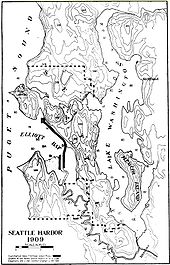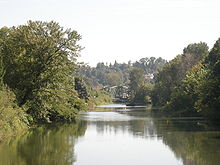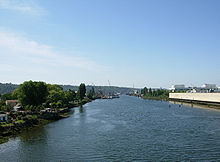- Duwamish River
-
Duwamish River River The lower Duwamish Waterway and the First Avenue South Bridge (State Route 99), looking north. Slips 1, 2, and 3 can be seen on the eastern bank. Kellogg Island is the crescent-shaped island in the upper right portion. Terminal 115 is located in the central portionCountry United States State Washington Cities Seattle, Tukwila Source Green River Mouth Elliott Bay Length 12 mi (19 km) The Duwamish River is the name of the lower 12 miles (19 km) of Washington state's Green River. Its industrialized estuary is known as the Duwamish Waterway.
Contents
History
Until 1906, the White and Green Rivers combined at Auburn, and joined the Black River at Tukwila to form the Duwamish. In 1906, however, the White River changed course following a major flood and emptied into the Puyallup River as it does today. The lower portion of the historic White River—from the historic confluence of the White and Green Rivers to the conjunction with the Black River—is now considered part of the Green River. Later, in 1911 the Cedar River was diverted to empty into Lake Washington instead of into the Black River; at that time, the lake itself still emptied into the Black River. Then, with the opening of the Lake Washington Ship Canal in 1916, the lake's level dropped nearly nine feet and the Black River dried up. From that time forward, the point of the name change from Green to Duwamish is no longer the confluence of the Green and Black Rivers, though it has not changed location.[1]
The native Lushootseed name of the Duwamish River (and of the Cedar River) was Dxwdəw. The Lushootseed name of the Duwamish tribe was Dxw'Dəw?Abš or Dkhw'Duw'Absh. Both of these have been anglicized as Duwamish.
Modern use
The Duwamish Waterway empties into Elliott Bay in Seattle, divided by the man-made Harbor Island into two channels, the East and West Waterways.
Due to 20th century industrial contamination, the lower 5 miles (8.0 km) of the Duwamish was declared a Superfund site by the United States Environmental Protection Agency. The contaminants include PCBs, PAHs, mercury, and phthalates.[2] The cleanup of the river has been controversial: the original plan was to dredge the river and dump the resulting sludge in Tacoma's Commencement Bay, 26 miles (42 km) to the southwest. Local opposition to this plan forced the sludge to be shipped to Klickitat County in south central Washington.[3]
Along with the contaminants already mentioned above the Duwamish River faces other types of pollution as well. One other major form of pollution is fecal coliform caused by sewage overflow. Even if these overflows were to be cleaned up the overall quality of the water would not improve much. Contamination would still occur from farms, surface runoff, wildlife, or failing septic tanks.[4] Also, the Duwamish River's most common pollutant is petroleum. This is because it is used in many different ways by many different groups of people.[5]
Wildlife
Despite the industrialization of the Duwamish river, it remains an important habitat for the thousands of salmon and trout that visit the marshes and estuaries each year to spawn. The Duwamish supports chinook, coho, chum and steelhead, not to mention the more rare pink, sockeye, sea-run cutthroat trout and bull trout.[6] Many of the animal species found in or around the river contain an unhealthy amount of contaminants. For example, other than salmon, any type of fish or shellfish found in the river is unfit for human consumption. It was found that PCB levels in fish and crab that live in the waterway most of their lives are 35 to 110 times higher than in Puget Sound salmon. The Ecological Risk Assessment also found that river otters from the Lower Duwamish River might be exposed to such high levels of PCBs that the growth or survival of their offspring may be reduced.[7]
In popular media
In the television series The 4400 the character Jordan Collier annexes a square mile of Seattle property and declares it an autonomous city called Promise City. The characters in the show claim that this is a portion of the "Duwamish River delta" and refer to it as one of the most polluted locations in the country. However, the map that many characters use for this location does not correspond to the Duwamish river at all (much less the delta), and in fact all scenes featuring Promise City were shot in Vancouver (presumably at a location within the Burrard Inlet).
See also
References
- ^ "The Green-Duwamish: A River System Re-Plumbed", The Green-Duwamish River: Connecting people with a diverse environment. Duwamish River Cleanup Coalition/TAG. No date, appears to be 2008 or 2009.
- ^ "Lower Duwamish Waterway Site". Region 10 Cleanup. U.S. Environmental Protection Agency. http://yosemite.epa.gov/r10/cleanup.nsf/sites/lduwamish. Retrieved 2009-04-04.
- ^ Paulson, Tom (2003-09-11). "Tainted sludge won't go to Tacoma". Seattle Post-Intelligencer. http://www.seattlepi.com/local/139087_sludge11.html.
- ^ Stakeholder Committee Report : Combined Sewer Overflow Water Quality Assessment for the Duwamish River and Elliott Bay. Seattle, WA: King County Department of Natural Resources. 1999
- ^ Impacts of Environmental Problems on the Reuse and Redevelopment of the Properties in the Duwamish Industrial Area. Seattle, WA: Remediation Technologies, Inc. 1994
- ^ "Seattle's Aquatic Environments: Duwamish Estuary" (PDF). City of Seattle. http://www.seattle.gov/util/stellent/groups/public/@spu/@ssw/documents/webcontent/spu01_002696.pdf. Retrieved 2009-04-04.
- ^ "Lower Duwamish Waterway Superfund Site" (PDF). Region 10 Cleanup. U.S. Environmental Protection Agency. June 2008. http://yosemite.epa.gov/r10/CLEANUP.NSF/LDW/Fact+Sheets/$FILE/LDW-FAQ-FS-08.pdf. Retrieved 2008-11-03.
External links
- Partnow, Jessica (September 24–28, 2007). "Life on the Duwamish:Rediscovering Seattle's Dirty South". KUOW-FM. http://www.kuow.org/specials/2007/duwamish.php
- McClure, Robert (November 26–28, 2007). "A River Lost? Decision time on the Duwamish". The Seattle Post-Intelligencer. http://www.seattlepi.com/specials/duwamish/
Coordinates: 47°35′04″N 122°21′37″W / 47.58444°N 122.36028°W
Categories:- Rivers of Washington (state)
- Ports and harbors of Washington (state)
- Landforms of King County, Washington
Wikimedia Foundation. 2010.




